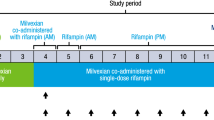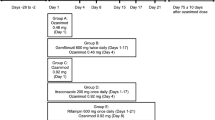Abstract
Gender can be an important variable in the absorption and disposition of some drugs. In this open-label study, 15 healthy, nonsmoking women received a single 600-mg oral dose of rifapentine. Plasma samples were obtained at frequent intervals for up to 72 hr after the dose to determine the pharmacokinetic (PK) parameters of rifapentine and its active metabolite, 25-desacetyl-rifapentine. Peak plasma rifapentine concentrations (Cmax ) were observed 5.9 hr after ingestion of the single dose. The mean area under the rifapentine plasma concentration–time curve [AUC(0 → ∞ )] was 325 μg · hr ml and the mean elimination half-life (t1/2 ) was 16.3 hr. Plasma concentrations for the 25-desacetyl metabolite peaked at 15.4 hr after the rifapentine dose and declined with a terminal half-life of 17.3 hr. These rifapentine and 25-desacetyl-rifapentine PK data in women were compared to data generated previously in healthy men. Striking similarities in the PK profiles of parent drug and metabolite were found in the two populations. Mean differences in rifapentine CL/F (12%) and t1/2 (2%) were small. The only adverse event reported in the female subjects was discoloration of the urine. Based on these PK and safety data, no dosage adjustments for rifapentine based on gender are recommended.
Similar content being viewed by others
REFERENCES
W. Wehrli. Rifampin: mechanisms of action and resistance. Rev. Infect. Dis. 5(Suppl. 3)S407–S411 (1983).
J. M. Dickinson and D. A. Mitchison. In vitro activity of selected rifamycins against rifampicin-resistant M. tuberculosis and MAIS-complex mycobacteria. Tubercle 68:177–182 (1987).
L. B. Heifets, P. J. Lindholm-Levy, and M. A. Flory. Bactericidal activity in vitro of various rifamycins against M. avium and M. tuberculosis. Am. Rev. Resp. Dis. 141:626–630 (1990).
N. Mor, B. Simon, N. Mezo, and L. Heifets. Comparison of activities of rifapentine and rifampin against Mycobacterium tuberculosis residing in human macrophages. Antimicrob. Agents Chemother. 39:2073–2077 (1995).
K. Reith, A. Keung, P. C. Toren, M. G. Eller, L. Cheng, and S. J. Weir. Mass balance and metabolism of 14C-rifapentine in healthy volunteers. Drug Metab. Dispos. (submitted for publication).
A. T. Birmingham, A. J. Coleman, M. L'E. Orme, B. K. Park, N. J. Pearson, A. H. Short, and P. J. Southgate. Antibacterial activity in serum and urine following oral administration in man of DL473 (a cyclopentyl derivative of rifampicin). Br. J. Clin. Pharmacol. 6:455P–456P (1978).
G. Buniva, D. Sassella, and G. M. Frigo. Pharmacokinetics of rifapentine in man. Proc. Int. Congr. Chemother. 111:29–33 (1983).
A. C. F. Keung, T. D. Miller, V. I. Green, M. Ames, M. G. Eller, and S. J. Weir. Bioavailability (BA) and food effect study of rifapentine in healthy adults [abstract]. Pharm. Res. 12(Suppl.): S419 (1995).
Y. Biya, N. Xikuam, Z. Lizhen, and Z. Fengying. Absorption and elimination of cyclopentyl-rifamycin in human subjects. Chinese J. Tuberc. Resp. Dis. 10:267–268 (1987).
S. L. Chan, W. W. Yew, J. H. D. Porter, K. P. W. J. McAdam, B. W. Allen, and J. M. Dickinson. Comparison of Chinese and Western rifapentines and improvement of bioavailability by prior taking of various meals. Int. J. Antimicrob. Agents 3:267–274 (1994).
Z. Qing, C. Yijan, and Z. Yingyuan. Clinical pharmacokinetic study on rifapentine. Chinese J. Antibiot. 19:456–458 (1994).
C. Zheng, L. Yi, and Z. Huiyan. Pharmacokinetics of domestic rifapentine in patients with acute pulmonary infections. Chinese J. Antibiot. 12:333–336 (1987).
A. Keung, M. G. Eller, K. A. McKenzie, and S. J. Weir. Single and multiple dose pharmacokinetics of rifapentine and its active metabolite 25-desacetyl-rifapentine in man. Pharmacol. Ther. (submitted for publication).
J. C. Bennet. Inclusion of women in clinical trials: Policies for population subgroups. Int. J. Tuber. Lung Dis. 329:288–292 (1993).
R. B. Merkatz, R. Temple, S. Sobel, K. Feiden, and D. A. Kessler. Women in clinical trials of new drugs. A change in Food and Drug Administration policy. New Engl. J. Med. 329:292–296 (1993).
C. V. Fletcher, E. P. Acosta, and J. M. Strykowski. Gender differences in human pharmacokinetics and pharmacodynamics. J. Adolescent Health 15:619–629 (1994).
C. H. Gleiter and U. Gundert-Remy. Gender differences in pharmacokinetics. Eur. J. Drug Metab. Pharmacokin. 21:123–128 (1996).
R. Z. Harris, L. Z. Benet, and J. B. Schwartz. Gender effects in pharmacokinetics and pharmacodynamics. Drugs 50:222–239 (1995).
K. A. Yonkers, J. C. Kando, J. O. Cole, and S. Blumenthal. Gender differences in pharmacokinetics and pharmacodynamics of psychotropic medication. Am. J. Psychiat. 149:587–595 (1992).
J. C. Kando, K. A. Yonkers, and J. O. Cole. Gender as a risk factor for adverse events to medications. Drugs 50:1–6 (1995).
American College of Clinical Pharmacy. ACCP White paper: Women as research subjects. Pharmacotherapy 13:534–542 (1993).
R. Scotti. Sex differences in blood levels of some antibiotics. Chemotherapy 18:205–211 (1973).
H. Iwainsky, K. Winsel, E. Werner, and H. Eule. On the pharmacokinetics of rifampicin during treatment with intermittent administration. II. Influence of age and sex of the patients. Scand. J. Resp. Dis. 57:5–11 (1976).
L. Verbist. Rifampicin blood levels in man. Acta Tuberc. Pneumol. Belg. 60:288–298 (1969).
M. D. Holland. Rifampicin—what dose for pulmonary tuberculosis? South Afr. Med. J. 46:604–608 (1972).
D. C. Colborn, R. C. Li, and P. K. Narang. Influence of gender on rifabutin (R) kinetics [abstr.]. Clin. Pharmacol. Ther. 53:182 (1993).
F-J. Leinweber. Possible physiological roles of carboxylic ester hydrolases. Drug Metab. Rev. 18:379–439 (1987).
L. Verbist. Pharmacological study of rifampicin after repeated high dosage during intermittent combined therapy. I. Variation of the rifampicin serum levels. Respiration 28(Suppl. 7):7–16 (1971).
T. F. Blaschke and M. H. Skinner. The clinical pharmacokinetics of rifabutin. Clin. Infect. Dis. 22(Suppl. 1):S15–S22 (1996).
G. Cocchiara, M. Strolin Benedetti, G. P. Vicario, M. Ballabio, B. Gioia, S. Viogglio, and A. Vigevani. Urinary metabolites of rifabutin, a new antimycobacterial agent, in human volunteers. Xenobiotica 19:769–780 (1989).
E. Iatsimirskaia, S. Tulebaev, E. Storozhuk, I. Utkin, D. Smith, N. Gerber, and T. Koudriakova. Metabolism of rifabutin in human enterocyte and liver microsomes: Kinetic parameters, identification of enzyme systems, and drug interactions with macrolides and antifungal agents. Clin. Pharmacol. Ther. 61:554–562 (1997).
C. B. Trapnell, C. Jamis-Dow, R. W. Klecker, and J. M. Collins. Metabolism of rifabutin and its 25-desacetyl metabolite, LM565, by human liver microsomes and recombinant human cytochrome P-450 3A4: Relevance to clinical interaction with fluconazole. Antimicrob. Agents Chemother. 41:924–926 (1997).
R. Battaglia, E. Pianezzola, G. Salgarollo, G. Zini, and M. S. Benedetti. Absorption, disposition and preliminary metabolic pathway of 14C-rifabutin in animals and man. J. Antimicrob. Chemother. 26:813–822 (1990).
Author information
Authors and Affiliations
Rights and permissions
About this article
Cite this article
Keung, A.C.F., Eller, M.G. & Weir, S.J. Single-Dose Pharmacokinetics of Rifapentine in Women. J Pharmacokinet Pharmacodyn 26, 75–85 (1998). https://doi.org/10.1023/A:1023276808298
Published:
Issue Date:
DOI: https://doi.org/10.1023/A:1023276808298




